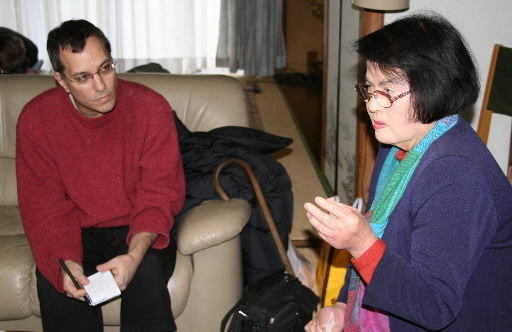A-bomb survivor Michiko Yamaoka dies at 82, one of “Hiroshima Girls” who received treatment in the U.S.
Feb. 8, 2013
by Michiko Tanaka, Staff Writer
Michiko Yamaoka, one of the 25 female A-bomb survivors who traveled to the United States 10 years after the atomic bombing to receive medical treatment for their keloid scars, died of pneumonia at a care facility in downtown Hiroshima at 10:01 a.m. on February 2. She was 82. Ms. Yamaoka, who was from Naka Ward, Hiroshima, dedicated herself to conveying her experience of the atomic bombing both at home and abroad. Her funeral will be held in Hiroshima at noon on February 4 with her sister-in-law, Nariko Yamaoka, serving as chief mourner.
Ms. Yamaoka was 15 and a student at Shintoku Girls’ High School when she was exposed to the atomic bomb while in today’s Mikawa-cho area in Naka Ward, about 800 meters from the hypocenter. A mobilized student at the time, she was on her way to the Hiroshima Central Telephone Exchange when the bomb exploded. Her face and arms were badly burned.
Ms. Yamaoka was one of the survivors who went to the United States for medical treatment in an effort made possible by Japanese and American citizens, including Reverend Kiyoshi Tanimoto of the Hiroshima Nagarekawa Methodist Church and the American journalist Norman Cousins. These women underwent treatment for their burn scars at Mount Sinai Hospital in New York for about one and a half years, starting in May 1955. Dubbed the “Hiroshima Girls,” their presence in the United States helped Americans realize the damage caused by the bomb.
Ms. Yamaoka began sharing her account of the bombing in 1979, after her mother passed away. She traveled to such countries as the United States and France to communicate the preciousness of life and peace. She suffered a stroke in 2006, but worked hard at her rehabilitation and continued conveying her experience to students visiting Hiroshima on school trips.
(Originally published on February 4, 2013)
Michiko Yamaoka, one of the 25 female A-bomb survivors who traveled to the United States 10 years after the atomic bombing to receive medical treatment for their keloid scars, died of pneumonia at a care facility in downtown Hiroshima at 10:01 a.m. on February 2. She was 82. Ms. Yamaoka, who was from Naka Ward, Hiroshima, dedicated herself to conveying her experience of the atomic bombing both at home and abroad. Her funeral will be held in Hiroshima at noon on February 4 with her sister-in-law, Nariko Yamaoka, serving as chief mourner.
Ms. Yamaoka was 15 and a student at Shintoku Girls’ High School when she was exposed to the atomic bomb while in today’s Mikawa-cho area in Naka Ward, about 800 meters from the hypocenter. A mobilized student at the time, she was on her way to the Hiroshima Central Telephone Exchange when the bomb exploded. Her face and arms were badly burned.
Ms. Yamaoka was one of the survivors who went to the United States for medical treatment in an effort made possible by Japanese and American citizens, including Reverend Kiyoshi Tanimoto of the Hiroshima Nagarekawa Methodist Church and the American journalist Norman Cousins. These women underwent treatment for their burn scars at Mount Sinai Hospital in New York for about one and a half years, starting in May 1955. Dubbed the “Hiroshima Girls,” their presence in the United States helped Americans realize the damage caused by the bomb.
Ms. Yamaoka began sharing her account of the bombing in 1979, after her mother passed away. She traveled to such countries as the United States and France to communicate the preciousness of life and peace. She suffered a stroke in 2006, but worked hard at her rehabilitation and continued conveying her experience to students visiting Hiroshima on school trips.
(Originally published on February 4, 2013)








